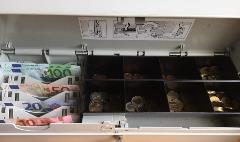Garage sales are great ways to multitask. Not only will you make extra cash, but the event will also help you declutter your home. If the decluttering aspect of your garage sale is your main goal, then you can take a laid-back approach to planning the occasion. However, if you're serious about earning extra money, you will need to put more effort into arranging your garage sale.
Beginning the Planning Process 
The first step to holding a successful garage sale is to select a date for the event as well as the time of day that you intend to hold it. Most people choose weekend days because garage sale shoppers are usually on the prowl for good deals when the weekend arrives, but you should do a little research about garage sales in your area to determine the best day of the week for the event based on where you live.
If you're planning to have your garage sale over a holiday weekend, you could schedule the occasion for a Thursday or a Sunday. To attract a larger crowd, begin your garage sale early in the day. This will let people attend your sale and still have time for leisure activities. Consider holding your sale on a Friday or a Saturday from 6 a.m. to noon.
Before settling on a date, check your area's local calendar to avoid competing with major events like a fair, rodeo or parade. Also, many people receive their paychecks at the end of the month. If you hold your yard sale when more people have disposable income, you may sell more of your stuff.
You'll also need to decide whether to hold your garage sale in the winter, spring, summer or fall. Most people have them in the summer because of the warm weather, but if you can arrange yours for a time when the weather is moderate, you may have more shoppers. Late spring or the first week or two of fall is usually the best time to hold your garage sale regardless of your location.
Gathering Your Merchandise
If you have an unused space or room in your home, consider setting up two or three boxes for gathering merchandise. When you come across an item that you no longer need or want, store it in one of the boxes until you have enough stuff for a garage sale. With a little extra organization, you can decrease the amount of preparation that you'll need to get ready for the big day. For instance, assign each box a category and store your garage sale odds and ends in the appropriate box. 
As the day of your garage sale draws near, scour your home for additional garage sale merchandise. Search through your closets, basement and attic. Check the garage for items that are just sitting on a shelf collecting dust as well as every bedroom in your home for items that are ready for a new place to live. Garage sale shoppers will buy things like old VHS tapes, CDs and even used perfume, so be aggressive as you consider the stuff that you no longer need or want.
After gathering your garage sale merchandise, assess the amount of stuff that you're planning to sell. To draw in enough shoppers, you need to have a lot of things available. Pro garage sale shoppers often drive past the ones that only have a few items for sale. If it looks like your sale is going to be skimpy, check with a few of your neighbors or family members to see if they'll participate in your garage sale with you. Multi-family garage sales tend to attract more shoppers.
Advertise Your Event
The old adage "You have to spend money to make money" is often accurate, at least when it comes to garage sales. In this case, you'll need to spend money placing an ad in your local newspaper. People who  take their garage sale shopping seriously check the newspaper for information about sales in their area. Before writing your ad, confirm how much space is included for the ad price. If you write too much and go over the word limit, the paper will charge you per word. This adds up quickly. Write an ad that's concise. Tell people what you're selling, but list the big ticket items first. The most popular things to sell include furniture, toys, and collectibles. Your ad should feature your address, the dates that you'll be holding the garage sale and the times that you intend your sale to run.
take their garage sale shopping seriously check the newspaper for information about sales in their area. Before writing your ad, confirm how much space is included for the ad price. If you write too much and go over the word limit, the paper will charge you per word. This adds up quickly. Write an ad that's concise. Tell people what you're selling, but list the big ticket items first. The most popular things to sell include furniture, toys, and collectibles. Your ad should feature your address, the dates that you'll be holding the garage sale and the times that you intend your sale to run.
Today, social media is a great way to advertise your garage sale. Let your Facebook friends know when you'll be having your sale, and ask them to share the information with their friends. This can reach a large number of people. You can also tweet about it or display a few of the items that you intend to sell on Instagram.
Don't overlook Craigslist. If you live in a large city, this is an effective advertising tool. Garage sale shoppers check Craigslist for sales going on in their area. Along with your address and sale dates, consider adding a directional tip or two to help people find your home more easily. You can include a picture of what you're selling to tempt people to stop by.
On the day of your garage sale, post signs directing people to your home. Add them to major roadways that are close by. Include directional arrows on your signs and tell shoppers where to turn. Make your signs big, and write them on neon-colored poster board for increased visibility.
The Week Before Your Garage Sale
Take the time to price your merchandise individually instead of grouping similar items in boxes that display one price. As your garage sale proceeds, shoppers will mix things up when digging for finds, and you'll struggle to stay organized without individual pricing. Price items using a roll of manila tape and a permanent marker. This is more affordable than buying price tags, and the tape will remain in place.
If you're not sure what you should ask for your belongings, consult an online guide. Generally speaking, you should price clothing from $1 to $5 and books for $1. You can sell DVDs for $2 or $3 while used  kitchen appliances usually go for $7 to $15.
kitchen appliances usually go for $7 to $15.
A day or two before your garage sale, stop by the bank for change. Be sure to get fives, ones and a minimum of $20 in quarters. Change boxes come in handy because you can keep your money nicely organized. You can even set larger bills underneath the tray for safekeeping. If you don't have a change box, ask your bank teller for reusable cash envelopes that you can take home.
Tables are a professional way to display the items that you're selling. In addition, clothing racks come in handy if you're selling a lot of shirts, dresses and pants. You could also string a rope across the top of your garage door opening to hang items instead of using a rack. If you don't have tables that you can use for your sale, consider laying blankets on your grass or driveway to display items. Before the sale, collect plastic bags to give to your shoppers to make it easier for them to transport their merchandise home.
The Day of the Garage Sale
On the day of your garage sale, set your alarm clock for an early hour to get everything out and organized. Make sure that your merchandise is priced. Also, set up a comfortable chair where your shoppers can easily spot you. If you're selling anything that needs power to operate, be sure to have an extension cord or power bar nearby so that people can confirm that it's working.

Prepare yourself to make small talk with those who come to your sale. You should also be ready to haggle. Garage sale shoppers love to make a deal. Before the start of your sale, decide how much you're willing to decrease your prices. This amount will depend on whether you're holding the sale to declutter or make money. Have a family member or a friend run the garage sale with you. Not only will this ensure that you have company during lags, but it will also make it easier for you to take breaks.
The Aftermath
Once you've decided to call it a day on your garage sale, you'll need to deal with the aftermath. If you have leftover items, donate them to your favorite charity. After you've parceled out your leftovers, count your money and store your tables and clothing racks for next year's garage sale.